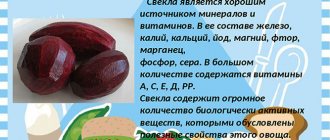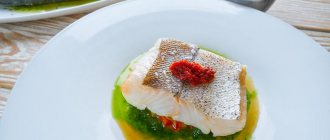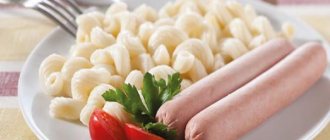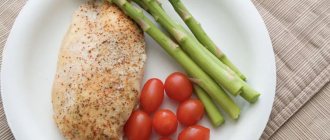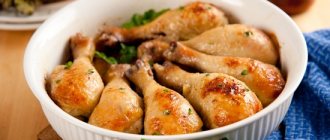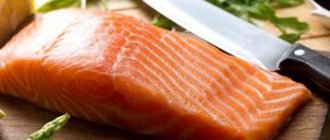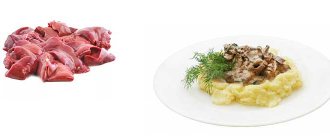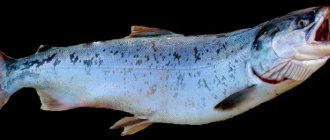Differences from sausage
Boiled sausage (the calorie content of 1 piece depends not only on the method of preparation, but also on the type of sausage), despite the similarity of taste with traditional boiled sausage, has a number of characteristic features that distinguish it from the usual meat-containing product.
These are the following features:
- Product size. Sausage is sold in a form ready for consumption, while frankfurters require pre-cooking. So that the consumer does not have any difficulties with preparing sausages, the manufacturer makes them more compact, which makes it possible to cook the product in question in a small saucepan.
- Cooking method . High-quality sausage is compressed minced meat in a casing, and sausages are finely chopped compressed meat or its substitute in a natural or artificial casing.
- Compound. To rationalize pricing in the production of sausages, a mixture of two types of meat, expensive and cheap, for example, pork and beef or pork and chicken, is often used. Sausage involves the presence of one type of meat, most often pork.
- The presence of artificial additives and secondary raw materials . Sausages belonging to the medium and low price category may include leather, offal, soy, flour, starch, flavorings, dyes, and flavorings.
Mashed potatoes with sausage calories. Why do we eat sausages, calorie content
The popularity of sausages is beyond doubt - these simple semi-finished products have long been widely used in cooking both as “quick” dishes and as a basis for complex and tasty dishes. They are a real lifesaver for busy people who don’t have time to prepare a meat or vegetable dish for dinner or lunch. Many mothers use sausages to feed their children, as children love them very much, although this is not the healthiest product for feeding children.
The main difference between sausages and other sausages is that they are eaten after heat treatment - boiling, stewing, frying or grilling. The quality varies - the cheapest, and, as a rule, low-quality ones contain very little minced meat and many additives such as vegetable protein (soy), starch, flavoring and aromatic additives, preservatives, etc. It’s easy to guess that such sausages are not the most desirable food. The higher the meat content, the better the taste, the higher the quality and the more benefits for the body. GOST standards adopted in the USSR allowed the meat content in sausages to be at least 50%. Nowadays, production often uses not GOST standards, but technical specifications (TU), which, unfortunately, allow for a lower meat content (10% or even less).
The calorie content also depends on the composition, although on average it remains at the level of 300 kcal per 100 g. Chicken sausages contain fewer calories than pork or beef. Sausages with soy protein may have fewer calories, but not everyone approves of soy products. Some of the most popular types of sausages are “Dairy” and “Bavarian”; smoked varieties (for example, Munich or hunting) are also in demand.
Regular sausages can hardly be called a dietary dish, but no one disputes the fact that they are indeed very popular because of their taste, as well as ease of preparation. They can quickly satisfy your hunger - after all, the calorie content of sausages is really very high, since they contain a lot of fat. Everyone likes the taste, although few people think that they owe their taste not to meat, but to various additives - salt, spices, flavor enhancers, preservatives, flavorings. Sausages are very easy to cook - just boil them in water, so they are popular among those who do not have time for long cooking. Ease of preparation, high calorie content and the ability to quickly satisfy hunger at a relatively low price are one of the reasons for the popularity of sausages in school and university canteens.
However, nutritionists do not have a very high opinion of these sausages - as a rule, rather low-grade meat is used in their production (sinews, fat, tendons, intestines, joints and other not the most edible parts of the meat carcass). In addition, the composition includes many accompanying additives that are included in the formulation in order to increase the mass of the final product, but do not provide any benefit to the body and may even be harmful (such as saltpeter). Therefore, sausages are not recommended for consumption by children, pregnant or lactating women, as well as people with diseases of internal organs, gastrointestinal tract, liver, kidneys, biliary tract, thyroid gland (due to the content of preservatives, dyes, flavor enhancers and other chemical compounds), as well as diabetes (due to the high glycemic index of sausages) and obesity (due to the high calorie content of sausages). Also, do not forget that sausages contain cholesterol, which does not have the best effect on the functioning of the cardiovascular system.
Main Ingredients
Sausages are usually classified into types that suggest differences in the composition of the meat product in question:
| Type of sausages | Brief description of the composition |
| Classic dairy | The meat filling is placed in a cellophane wrapper. They have a soft pink color and a smooth surface. In terms of thickness, milk sausages are much thinner than similar meat products. The composition includes pork, beef, milk powder and eggs. |
| Creamy | They also have a light pink color, but in appearance they look larger than milk sausages. They are produced in cellophane or natural casing (the price of the product depends on the type of casing). Creamy sausages contain beef, pork, water, spices and dry cream. |
| Doctoral degrees | The color of quality doctor's sausages is pink. In the production of the product in question, only a cellophane shell is used. The composition is similar to doctor's sausage, prepared according to a recipe including beef, pork and milk. |
| Amateur | They are a brown sausage product in a cellophane or natural casing. The product in question is made from smoked pork and a small amount of beef. |
| Russians | Sausages prepared according to GOST have a pinkish tint. This type of sausage is produced exclusively in natural casings. Its composition includes minced pork and beef, seasoned with a large number of spices. |
| Special | This variety of sausage can be deep pink or have a pale hue. Regardless of color, the product consists of combined minced meat with a high concentration of herbs and spices. In production, cellophane or natural casing is used. |
| Dietary | To obtain a product with minimal calorie content, manufacturers use minced meat made from poultry meat. The meat component is placed in a natural or cellophane casing, at the discretion of the specific supplier. The type of sausage in question has a color characteristic of poultry meat - as light as possible with a yellowish tint. |
| Soybeans | Consist entirely of soy, placed in vacuum or cellophane packaging. |
| With cheese | They are pink in color with light or yellowish inclusions (pieces of cheese). Produced in natural or cellophane packaging. Contains pork, beef and cheese. |
| Hunter's sausages | The hollows consist of smoked meat (pork or beef, at the manufacturer’s choice). They are brown in color and supplied in a natural casing. |
| Munich | The composition includes veal, lard, herbs and spices. The product in question is produced in a natural casing and has a white or light yellow color. |
| Viennese | This type of sausage is usually long and light pink in color. The composition includes pork, beef and natural casing. |
How many carbohydrates are in a sausage? Milk sausages
Milk sausages are a type of boiled sausage products made from meat with the addition of milk powder. Milk sausages are produced in a natural casing made of gelatin or animal intestines, light pink or pink-brown in color, medium thickness, in the form of long sausages. The taste of milk sausages is pleasant, with a slight aroma of smoke and milky aroma. The production of milk sausages is regulated by GOST R 52196-2011.
Calorie content of milk sausages
The calorie content of milk sausages is, on average, 266 kcal per 100 grams of product. Calorie content depends on the manufacturer and may vary.
Composition and beneficial properties of milk sausages
The product contains: pork, beef, milk powder, salt, egg powder, sugar, black and allspice, nutmeg (sometimes replaced with cardamom). Milk sausages contain easily digestible protein and are suitable for feeding children and the elderly.
Harm from dairy sausages
Sausages, like any boiled meat product, contain a lot of salt, which retains liquid and can lead to edema. Milk sausages can cause allergic reactions; people with lactose intolerance should use the product with caution.
Selection and storage of milk sausages
It is best to purchase milk sausages in vacuum or sealed packages made by a trusted manufacturer. The sausages must be the same size and uniform color, without whitish or dark spots, or drops of water on the casing. The shelf life of milk sausages indicated on the packages usually does not exceed 30 days (calorizator). Milk sausages should be stored in the refrigerator; they can be frozen to extend their shelf life.
Dairy sausages in cooking
Dairy sausages must be heat treated; they are boiled, fried, or grilled. Milk sausages can be added to meat soup, stewed vegetables, scrambled eggs and omelettes, and pizza. A traditional side dish for milk sausages is boiled pasta, mashed potatoes or fresh vegetable salad. Sausages in dough are a quick and budget-friendly dish for feeding unplanned guests. Some housewives prepare Olivier salad with sausages.
For more information about milk sausages, see Copying this article in whole or in part is prohibited.
Effect on health
Boiled sausage (calorie content of 1 piece allows those losing weight to eat the product daily), if consumed uncontrolled, may not only not have a positive effect on the human body, but may even harm it.
The negative impact of the type of meat product in question is:
- the presence of artificial additives, dyes and flavor enhancers that affect the functioning of the gastrointestinal tract;
- possible adaptation of the body to the taste properties of sausages (it is almost impossible to change eating habits in adulthood);
- chemical substances contained in minimal quantities in sausages provoke the need for the body to expend a large amount of resources on their digestion (despite the fact that some of them are not absorbed in principle, being deposited in the body and causing serious diseases, for example, gastritis);
- accumulation of salts with regular consumption of low-quality meat products (this leads to swelling, hypertension, inflammatory processes in the kidneys).
With the correct organization of the diet, including periodic consumption of boiled sausages, the product can have a positive effect on the human body.
Positive traits:
- magnesium and potassium contained in high-quality sausages help increase the elasticity of vascular walls and strengthen the heart muscle;
- B vitamins normalize the functioning of the central nervous system, improve memory and brain activity;
- iodine prevents the occurrence of thyroid diseases;
- strengthening the skeletal system with calcium and phosphorus;
- vitamin E improves skin condition, preventing the appearance of acne and acne;
- iron maintains hemoglobin in the blood at a normal level;
- The amino acids contained in sausages strengthen the soft tissues of the entire body as a whole.
Harm
The main harm to health is caused by low-quality products. Such sausages may contain substances that are dangerous to the body (they cause addiction):
- nitrates;
- carrageenan;
- phosphates;
- cochineal;
- nitrites.
Addiction is formed due to the effect on taste buds. The rest of the products seem bland compared to the sausages. The composition should contain 30% meat, but it is replaced with leather, animal fat, and poultry meat.
Other substances include:
- emulsions with proteins and fats;
- protein stabilizers.
The composition of the product does not allow it to be classified as meat. Its use may cause:
- allergies;
- problems with the digestive tract;
- chronic diseases.
Contraindications
Sausages should not be given to children under 3 years of age. The use of the product is prohibited for pregnant women and during lactation. This is due to the substances it contains. Men should also not overuse such products, as they reduce sperm activity.
Contraindications for eating sausages include the following diseases:
- liver;
- gallbladder;
- kidney;
- heart and blood vessels;
- reproductive organs;
- digestion;
- thyroid gland.
Also, people with the following diseases should not eat the product:
- gout;
- arthritis;
- obesity;
- arthrosis;
- diabetes mellitus
The nutritional value
The number of calories contained in the same type of sausage varies depending on the cooking method.
To ensure that a meat product does not harm the figure of someone losing weight, it is necessary to properly organize a new diet before including it:
- Study the composition of the selected type of sausage.
- Decide on the method of preparing them. It should not only help preserve the maximum amount of nutrients in the composition of sausages, but also not negatively affect the taste of the product.
- Calculate the calorie content of 1 piece. or 100 g of sausages.
- Determine the maximum allowable volume of sausages in the diet, based on the daily caloric intake and the BJU ratio calculated by a nutritionist.
To understand how to cook a specific type of sausage, it is recommended to use a table containing general information on the most popular types of meat products in question.
| Sausage variety | Calorie content and method of preparation |
| Milk sausages | Boiled – 156 Kcal per 1 piece; fried – 172 Kcal per 1 piece. |
| Beef sausages | Boiled – 160 Kcal per 1 piece; fried – 189 Kcal per 1 piece. |
| Chicken sausages | Boiled – 156 Kcal per 1 piece; fried – 169 Kcal per 1 piece. |
| Sausages with cheese | Boiled – 154 Kcal per 1 piece; fried – 165 Kcal per 1 piece. |
Useful material
According to GOST, natural sausage contains:
- ascorbic acid (as an antioxidant);
- pork;
- beef;
- sodium polyphosphate (stabilizer);
- water;
- nutmeg;
- egg products;
- black pepper;
- skim milk powder;
- sugar;
- nitrite salt.
Thanks to this composition, the product contains vitamins and minerals:
- tocopherol;
- B vitamins;
- calcium;
- potassium;
- iodine;
- magnesium;
- phosphorus;
- iron.
A high-quality product contains other useful substances - essential amino acids, which take part in the synthesis of tissue proteins. These components affect weight gain:
- phenylalanine;
- tryptophan;
- isoleucine;
- lysine;
- leucine;
- methionine;
- threonine;
- valine
2
Calorie content by different manufacturers
When counting calories, you must take into account the manufacturer of the product:
| Manufacturer, type of sausages | Calorie content per 100 grams | In one piece |
| Welcome, “Bavarian” | 230 | 115 |
| Welcome, “Smoked” | 240 | 120 |
| Welcome, “Doctors” | 230 | 115 |
| Welcome, “Cocktail” | 210 | 105 |
| Welcome, “Dairy” | 250 | 125 |
| Welcome, with cheese | 259 | 130 |
| Welcome, “Creamy” | 190 | 95 |
| Welcome, “Krokha” | 240 | 120 |
| Welcome, smoked sausages | 310 | 279-341 |
| Welcome, pork sausages | 310 | 279–341 |
| Dymov, “Dairy” | 296 | 148 |
| Dymov, with Alpine cheese | 296 | 148 |
| Ostankino, “Dad Can” | 247 | 124 |
| Ostankino, “Juicy” | 198 | 99 |
| Ostankino, “Filleinye” | 175 | 88 |
| Snezhana, “Juicy” with cheese | 200 | 110 |
| Egoryevskaya FKG, boiled with whole milk | 304 | 152 |
| Egoryevskaya FKG, boiled with allspice | 304 | 152 |
| Egoryevskaya FKG, boiled with cheese in raw smoked bacon | 281 | 140 |
| Outskirts, boiled with natural milk | 277 | 139 |
| Outskirts, “Doctors” | 247 | 124 |
| Outskirts, “Boiled” | 179 | 89 |
| Outskirts, “Krokha” | 253 | 126 |
| Outskirts, “Dairy” | 296 | 149 |
| Klinsky, Klinsky sausages | 170 | 95 |
| Klinsky, sausages with cheese | 240 | 120 |
| Klinsky, Klin sausages | 280 | 140 |
| Klinsky, “Dairy” | 296 | 149 |
| Klinsky, Klinsky pork chops | 325 | 292 |
| MD Borodina, “Doctorskie” sausages | 275 | 247 |
| MD Borodina, “Bavarian” | 276 | 138 |
| MD Borodina, “Premium” | 211 | 105 |
| MD Borodina, “Dairy” | 296 | 149 |
| MD Borodina, “Creamy” | 211 | 105 |
| MD Borodina, studs | 265 | 291 |
| Rublevsky, beef sausages “Lux” | 175 | 183 |
| Rublevsky, “Doctorskie” sausages | 273 | 300 |
| Rublevskie, pork sausages “Lux” | 175 | 193 |
| Rublevsky, “Vienna” | 251 | 125 |
| Rublevsky, “Doctors” | 178 | 89 |
| Rublevsky, “Dairy” | 300 | 150 |
| Rublevsky, Rublevsky sausages | 310 | 155 |
| Rublevskie, “Slivochnye” | 272 | 136 |
| Rublevsky, “Veal” | 265 | 132 |
| Rublevsky, Moskvoretskie spikki | 175 | 188 |
| Kolbuster, “Children’s” from beef and lean pork | 245 | 122 |
| Colbuster, “Fairy Tale” with dietary turkey meat | 245 | 122 |
